A Detailed Comparison of Sufism and Salafism within the Islamic Faith
VerifiedAdded on 2023/06/09
|7
|1831
|415
Essay
AI Summary
This essay provides a comparative analysis of Sufism and Salafism, two significant practices within Islam. It begins by defining both terms and tracing their historical origins, including the problems that led to their emergence and evolution. The essay examines the core tenets of Sufism, emphasizing its focus on mysticism, self-discipline, and spiritual connection with God. It explores the various definitions and schools of thought within Sufism, including Ethical, Philosophical, and Institutional Sufism. The essay then details the rise of Salafism as a reform movement within Sunni Islam, discussing its origins in the 19th century and its emphasis on returning to the practices of the early generations of Islam. It highlights the differences in approach between Sufism and Salafism, particularly regarding the interpretation of Islamic teachings and the relationship between God and believers. The essay further discusses the different varieties within both Sufism and Salafism, including the conservative and lenient forms of Salafism. The conclusion summarizes the key distinctions and suggests that a balanced approach may be the most suitable way to navigate the differences between these two Islamic practices. The essay concludes by providing a comprehensive list of references that support the analysis.

Essay
Paraphrase This Document
Need a fresh take? Get an instant paraphrase of this document with our AI Paraphraser
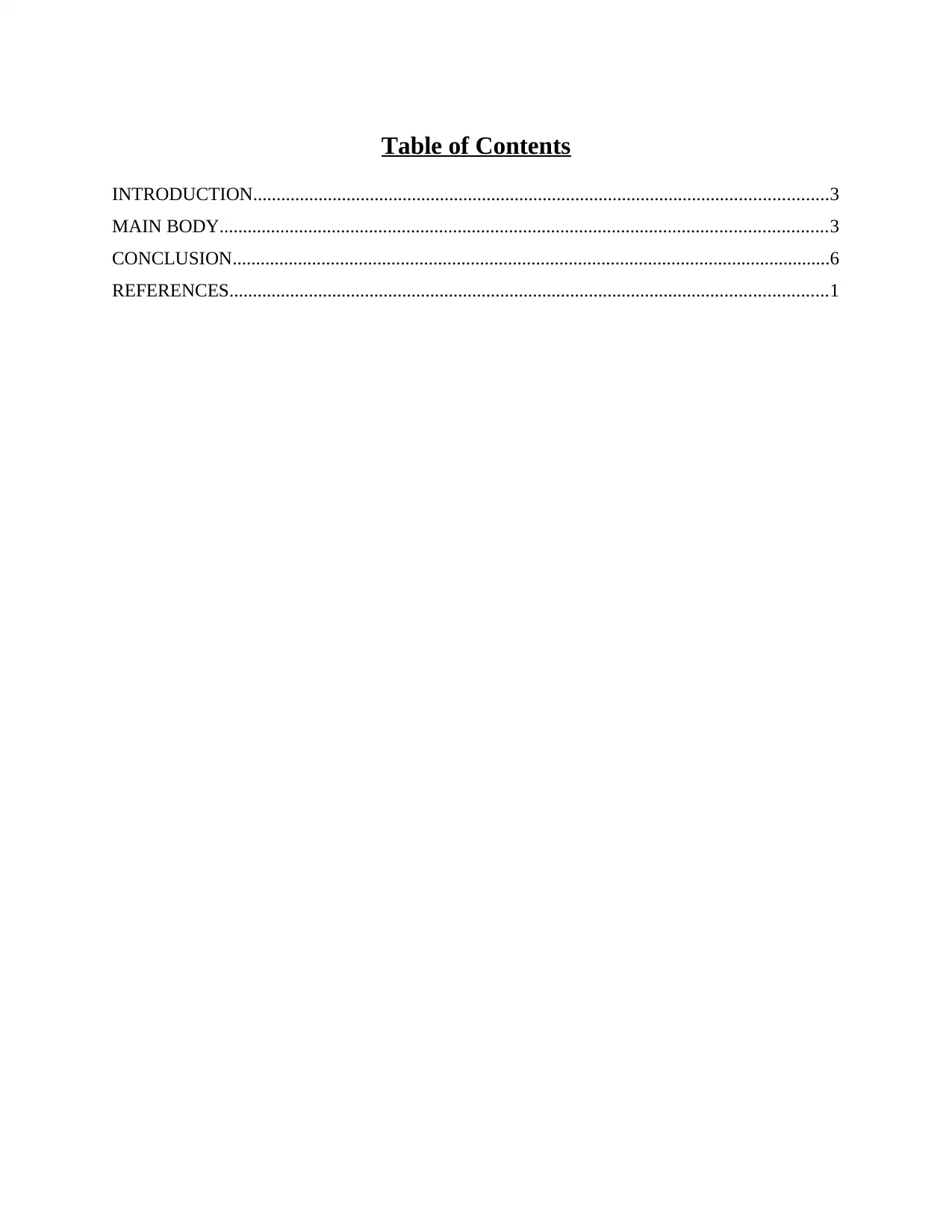
Table of Contents
INTRODUCTION...........................................................................................................................3
MAIN BODY..................................................................................................................................3
CONCLUSION................................................................................................................................6
REFERENCES................................................................................................................................1
INTRODUCTION...........................................................................................................................3
MAIN BODY..................................................................................................................................3
CONCLUSION................................................................................................................................6
REFERENCES................................................................................................................................1
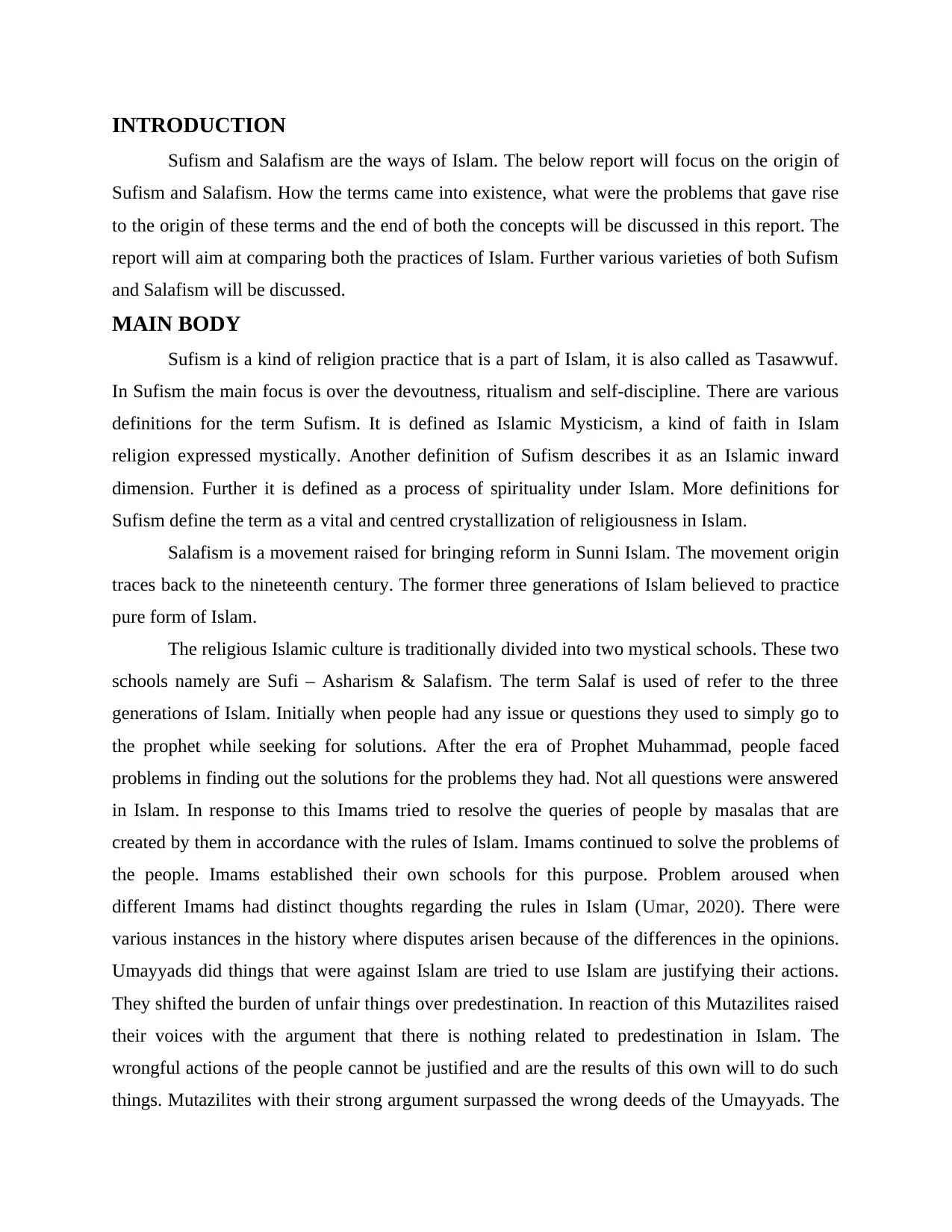
INTRODUCTION
Sufism and Salafism are the ways of Islam. The below report will focus on the origin of
Sufism and Salafism. How the terms came into existence, what were the problems that gave rise
to the origin of these terms and the end of both the concepts will be discussed in this report. The
report will aim at comparing both the practices of Islam. Further various varieties of both Sufism
and Salafism will be discussed.
MAIN BODY
Sufism is a kind of religion practice that is a part of Islam, it is also called as Tasawwuf.
In Sufism the main focus is over the devoutness, ritualism and self-discipline. There are various
definitions for the term Sufism. It is defined as Islamic Mysticism, a kind of faith in Islam
religion expressed mystically. Another definition of Sufism describes it as an Islamic inward
dimension. Further it is defined as a process of spirituality under Islam. More definitions for
Sufism define the term as a vital and centred crystallization of religiousness in Islam.
Salafism is a movement raised for bringing reform in Sunni Islam. The movement origin
traces back to the nineteenth century. The former three generations of Islam believed to practice
pure form of Islam.
The religious Islamic culture is traditionally divided into two mystical schools. These two
schools namely are Sufi – Asharism & Salafism. The term Salaf is used of refer to the three
generations of Islam. Initially when people had any issue or questions they used to simply go to
the prophet while seeking for solutions. After the era of Prophet Muhammad, people faced
problems in finding out the solutions for the problems they had. Not all questions were answered
in Islam. In response to this Imams tried to resolve the queries of people by masalas that are
created by them in accordance with the rules of Islam. Imams continued to solve the problems of
the people. Imams established their own schools for this purpose. Problem aroused when
different Imams had distinct thoughts regarding the rules in Islam (Umar, 2020). There were
various instances in the history where disputes arisen because of the differences in the opinions.
Umayyads did things that were against Islam are tried to use Islam are justifying their actions.
They shifted the burden of unfair things over predestination. In reaction of this Mutazilites raised
their voices with the argument that there is nothing related to predestination in Islam. The
wrongful actions of the people cannot be justified and are the results of this own will to do such
things. Mutazilites with their strong argument surpassed the wrong deeds of the Umayyads. The
Sufism and Salafism are the ways of Islam. The below report will focus on the origin of
Sufism and Salafism. How the terms came into existence, what were the problems that gave rise
to the origin of these terms and the end of both the concepts will be discussed in this report. The
report will aim at comparing both the practices of Islam. Further various varieties of both Sufism
and Salafism will be discussed.
MAIN BODY
Sufism is a kind of religion practice that is a part of Islam, it is also called as Tasawwuf.
In Sufism the main focus is over the devoutness, ritualism and self-discipline. There are various
definitions for the term Sufism. It is defined as Islamic Mysticism, a kind of faith in Islam
religion expressed mystically. Another definition of Sufism describes it as an Islamic inward
dimension. Further it is defined as a process of spirituality under Islam. More definitions for
Sufism define the term as a vital and centred crystallization of religiousness in Islam.
Salafism is a movement raised for bringing reform in Sunni Islam. The movement origin
traces back to the nineteenth century. The former three generations of Islam believed to practice
pure form of Islam.
The religious Islamic culture is traditionally divided into two mystical schools. These two
schools namely are Sufi – Asharism & Salafism. The term Salaf is used of refer to the three
generations of Islam. Initially when people had any issue or questions they used to simply go to
the prophet while seeking for solutions. After the era of Prophet Muhammad, people faced
problems in finding out the solutions for the problems they had. Not all questions were answered
in Islam. In response to this Imams tried to resolve the queries of people by masalas that are
created by them in accordance with the rules of Islam. Imams continued to solve the problems of
the people. Imams established their own schools for this purpose. Problem aroused when
different Imams had distinct thoughts regarding the rules in Islam (Umar, 2020). There were
various instances in the history where disputes arisen because of the differences in the opinions.
Umayyads did things that were against Islam are tried to use Islam are justifying their actions.
They shifted the burden of unfair things over predestination. In reaction of this Mutazilites raised
their voices with the argument that there is nothing related to predestination in Islam. The
wrongful actions of the people cannot be justified and are the results of this own will to do such
things. Mutazilites with their strong argument surpassed the wrong deeds of the Umayyads. The
⊘ This is a preview!⊘
Do you want full access?
Subscribe today to unlock all pages.

Trusted by 1+ million students worldwide
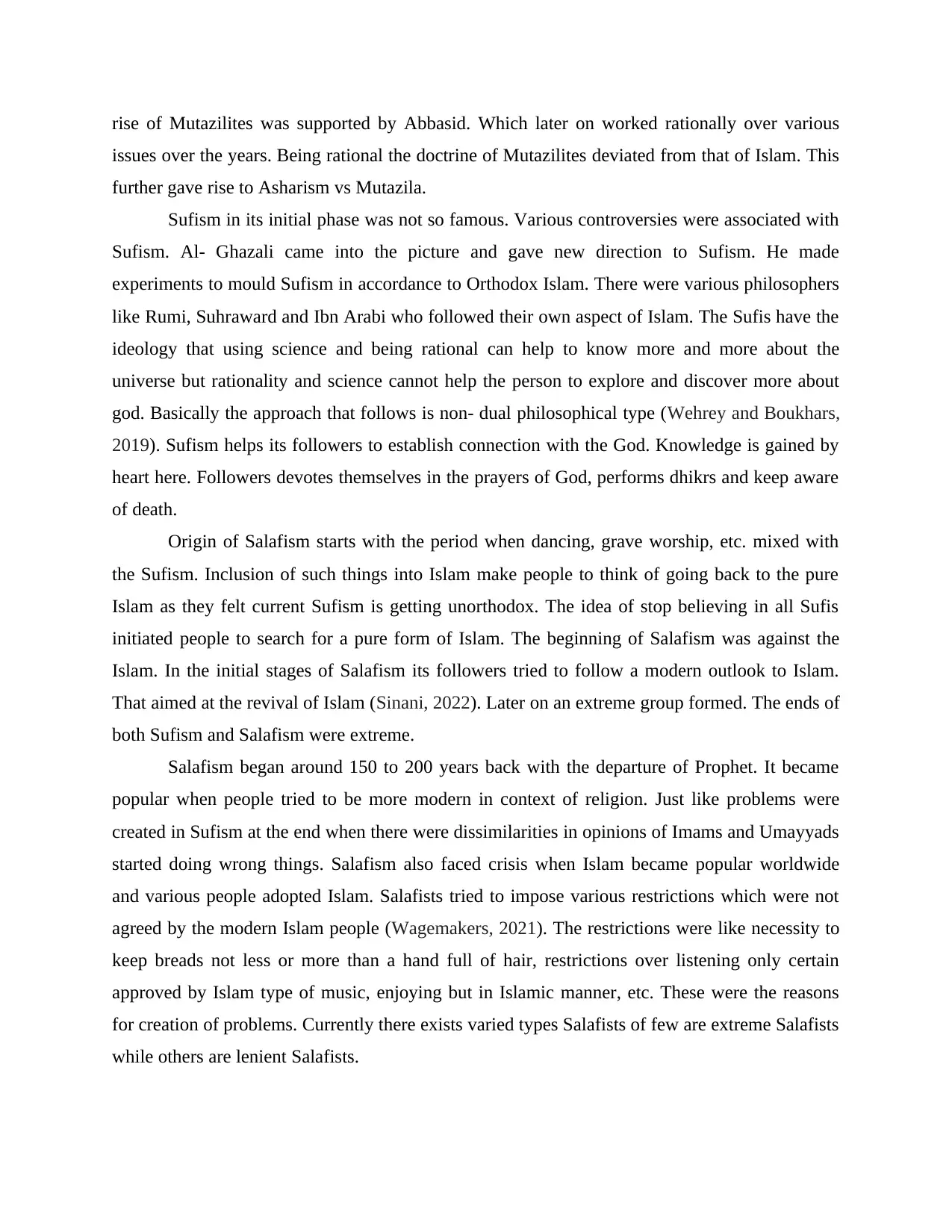
rise of Mutazilites was supported by Abbasid. Which later on worked rationally over various
issues over the years. Being rational the doctrine of Mutazilites deviated from that of Islam. This
further gave rise to Asharism vs Mutazila.
Sufism in its initial phase was not so famous. Various controversies were associated with
Sufism. Al- Ghazali came into the picture and gave new direction to Sufism. He made
experiments to mould Sufism in accordance to Orthodox Islam. There were various philosophers
like Rumi, Suhraward and Ibn Arabi who followed their own aspect of Islam. The Sufis have the
ideology that using science and being rational can help to know more and more about the
universe but rationality and science cannot help the person to explore and discover more about
god. Basically the approach that follows is non- dual philosophical type (Wehrey and Boukhars,
2019). Sufism helps its followers to establish connection with the God. Knowledge is gained by
heart here. Followers devotes themselves in the prayers of God, performs dhikrs and keep aware
of death.
Origin of Salafism starts with the period when dancing, grave worship, etc. mixed with
the Sufism. Inclusion of such things into Islam make people to think of going back to the pure
Islam as they felt current Sufism is getting unorthodox. The idea of stop believing in all Sufis
initiated people to search for a pure form of Islam. The beginning of Salafism was against the
Islam. In the initial stages of Salafism its followers tried to follow a modern outlook to Islam.
That aimed at the revival of Islam (Sinani, 2022). Later on an extreme group formed. The ends of
both Sufism and Salafism were extreme.
Salafism began around 150 to 200 years back with the departure of Prophet. It became
popular when people tried to be more modern in context of religion. Just like problems were
created in Sufism at the end when there were dissimilarities in opinions of Imams and Umayyads
started doing wrong things. Salafism also faced crisis when Islam became popular worldwide
and various people adopted Islam. Salafists tried to impose various restrictions which were not
agreed by the modern Islam people (Wagemakers, 2021). The restrictions were like necessity to
keep breads not less or more than a hand full of hair, restrictions over listening only certain
approved by Islam type of music, enjoying but in Islamic manner, etc. These were the reasons
for creation of problems. Currently there exists varied types Salafists of few are extreme Salafists
while others are lenient Salafists.
issues over the years. Being rational the doctrine of Mutazilites deviated from that of Islam. This
further gave rise to Asharism vs Mutazila.
Sufism in its initial phase was not so famous. Various controversies were associated with
Sufism. Al- Ghazali came into the picture and gave new direction to Sufism. He made
experiments to mould Sufism in accordance to Orthodox Islam. There were various philosophers
like Rumi, Suhraward and Ibn Arabi who followed their own aspect of Islam. The Sufis have the
ideology that using science and being rational can help to know more and more about the
universe but rationality and science cannot help the person to explore and discover more about
god. Basically the approach that follows is non- dual philosophical type (Wehrey and Boukhars,
2019). Sufism helps its followers to establish connection with the God. Knowledge is gained by
heart here. Followers devotes themselves in the prayers of God, performs dhikrs and keep aware
of death.
Origin of Salafism starts with the period when dancing, grave worship, etc. mixed with
the Sufism. Inclusion of such things into Islam make people to think of going back to the pure
Islam as they felt current Sufism is getting unorthodox. The idea of stop believing in all Sufis
initiated people to search for a pure form of Islam. The beginning of Salafism was against the
Islam. In the initial stages of Salafism its followers tried to follow a modern outlook to Islam.
That aimed at the revival of Islam (Sinani, 2022). Later on an extreme group formed. The ends of
both Sufism and Salafism were extreme.
Salafism began around 150 to 200 years back with the departure of Prophet. It became
popular when people tried to be more modern in context of religion. Just like problems were
created in Sufism at the end when there were dissimilarities in opinions of Imams and Umayyads
started doing wrong things. Salafism also faced crisis when Islam became popular worldwide
and various people adopted Islam. Salafists tried to impose various restrictions which were not
agreed by the modern Islam people (Wagemakers, 2021). The restrictions were like necessity to
keep breads not less or more than a hand full of hair, restrictions over listening only certain
approved by Islam type of music, enjoying but in Islamic manner, etc. These were the reasons
for creation of problems. Currently there exists varied types Salafists of few are extreme Salafists
while others are lenient Salafists.
Paraphrase This Document
Need a fresh take? Get an instant paraphrase of this document with our AI Paraphraser
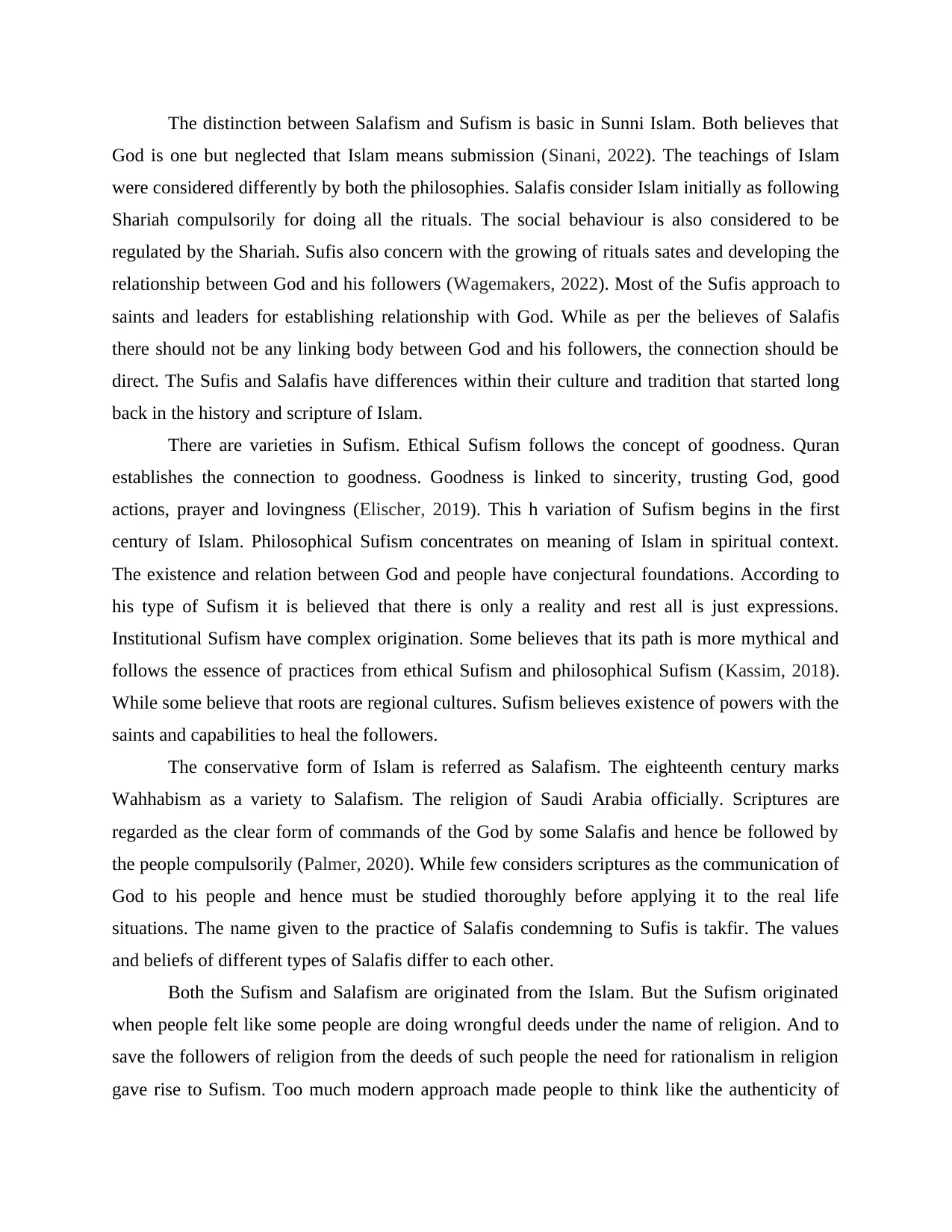
The distinction between Salafism and Sufism is basic in Sunni Islam. Both believes that
God is one but neglected that Islam means submission (Sinani, 2022). The teachings of Islam
were considered differently by both the philosophies. Salafis consider Islam initially as following
Shariah compulsorily for doing all the rituals. The social behaviour is also considered to be
regulated by the Shariah. Sufis also concern with the growing of rituals sates and developing the
relationship between God and his followers (Wagemakers, 2022). Most of the Sufis approach to
saints and leaders for establishing relationship with God. While as per the believes of Salafis
there should not be any linking body between God and his followers, the connection should be
direct. The Sufis and Salafis have differences within their culture and tradition that started long
back in the history and scripture of Islam.
There are varieties in Sufism. Ethical Sufism follows the concept of goodness. Quran
establishes the connection to goodness. Goodness is linked to sincerity, trusting God, good
actions, prayer and lovingness (Elischer, 2019). This h variation of Sufism begins in the first
century of Islam. Philosophical Sufism concentrates on meaning of Islam in spiritual context.
The existence and relation between God and people have conjectural foundations. According to
his type of Sufism it is believed that there is only a reality and rest all is just expressions.
Institutional Sufism have complex origination. Some believes that its path is more mythical and
follows the essence of practices from ethical Sufism and philosophical Sufism (Kassim, 2018).
While some believe that roots are regional cultures. Sufism believes existence of powers with the
saints and capabilities to heal the followers.
The conservative form of Islam is referred as Salafism. The eighteenth century marks
Wahhabism as a variety to Salafism. The religion of Saudi Arabia officially. Scriptures are
regarded as the clear form of commands of the God by some Salafis and hence be followed by
the people compulsorily (Palmer, 2020). While few considers scriptures as the communication of
God to his people and hence must be studied thoroughly before applying it to the real life
situations. The name given to the practice of Salafis condemning to Sufis is takfir. The values
and beliefs of different types of Salafis differ to each other.
Both the Sufism and Salafism are originated from the Islam. But the Sufism originated
when people felt like some people are doing wrongful deeds under the name of religion. And to
save the followers of religion from the deeds of such people the need for rationalism in religion
gave rise to Sufism. Too much modern approach made people to think like the authenticity of
God is one but neglected that Islam means submission (Sinani, 2022). The teachings of Islam
were considered differently by both the philosophies. Salafis consider Islam initially as following
Shariah compulsorily for doing all the rituals. The social behaviour is also considered to be
regulated by the Shariah. Sufis also concern with the growing of rituals sates and developing the
relationship between God and his followers (Wagemakers, 2022). Most of the Sufis approach to
saints and leaders for establishing relationship with God. While as per the believes of Salafis
there should not be any linking body between God and his followers, the connection should be
direct. The Sufis and Salafis have differences within their culture and tradition that started long
back in the history and scripture of Islam.
There are varieties in Sufism. Ethical Sufism follows the concept of goodness. Quran
establishes the connection to goodness. Goodness is linked to sincerity, trusting God, good
actions, prayer and lovingness (Elischer, 2019). This h variation of Sufism begins in the first
century of Islam. Philosophical Sufism concentrates on meaning of Islam in spiritual context.
The existence and relation between God and people have conjectural foundations. According to
his type of Sufism it is believed that there is only a reality and rest all is just expressions.
Institutional Sufism have complex origination. Some believes that its path is more mythical and
follows the essence of practices from ethical Sufism and philosophical Sufism (Kassim, 2018).
While some believe that roots are regional cultures. Sufism believes existence of powers with the
saints and capabilities to heal the followers.
The conservative form of Islam is referred as Salafism. The eighteenth century marks
Wahhabism as a variety to Salafism. The religion of Saudi Arabia officially. Scriptures are
regarded as the clear form of commands of the God by some Salafis and hence be followed by
the people compulsorily (Palmer, 2020). While few considers scriptures as the communication of
God to his people and hence must be studied thoroughly before applying it to the real life
situations. The name given to the practice of Salafis condemning to Sufis is takfir. The values
and beliefs of different types of Salafis differ to each other.
Both the Sufism and Salafism are originated from the Islam. But the Sufism originated
when people felt like some people are doing wrongful deeds under the name of religion. And to
save the followers of religion from the deeds of such people the need for rationalism in religion
gave rise to Sufism. Too much modern approach made people to think like the authenticity of
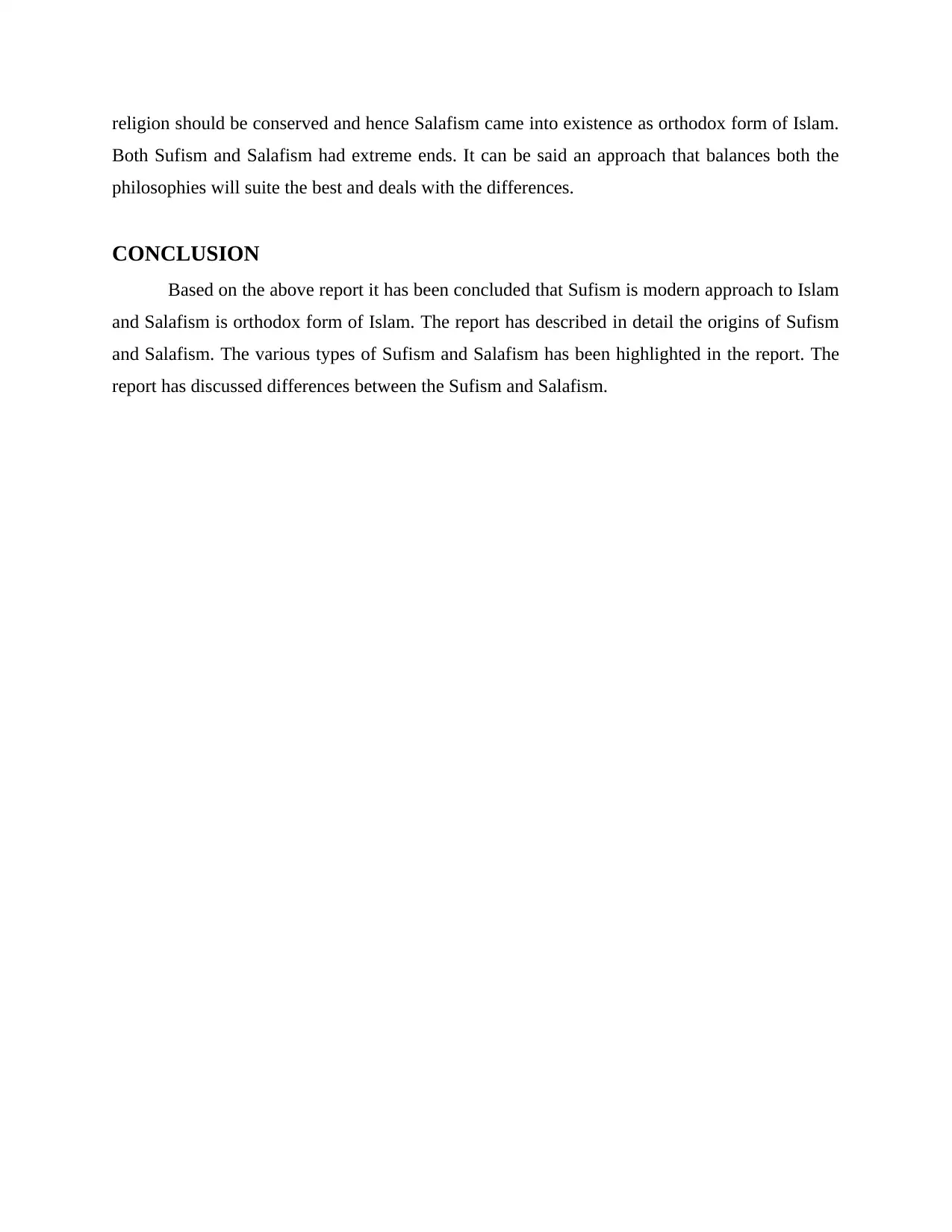
religion should be conserved and hence Salafism came into existence as orthodox form of Islam.
Both Sufism and Salafism had extreme ends. It can be said an approach that balances both the
philosophies will suite the best and deals with the differences.
CONCLUSION
Based on the above report it has been concluded that Sufism is modern approach to Islam
and Salafism is orthodox form of Islam. The report has described in detail the origins of Sufism
and Salafism. The various types of Sufism and Salafism has been highlighted in the report. The
report has discussed differences between the Sufism and Salafism.
Both Sufism and Salafism had extreme ends. It can be said an approach that balances both the
philosophies will suite the best and deals with the differences.
CONCLUSION
Based on the above report it has been concluded that Sufism is modern approach to Islam
and Salafism is orthodox form of Islam. The report has described in detail the origins of Sufism
and Salafism. The various types of Sufism and Salafism has been highlighted in the report. The
report has discussed differences between the Sufism and Salafism.
⊘ This is a preview!⊘
Do you want full access?
Subscribe today to unlock all pages.

Trusted by 1+ million students worldwide
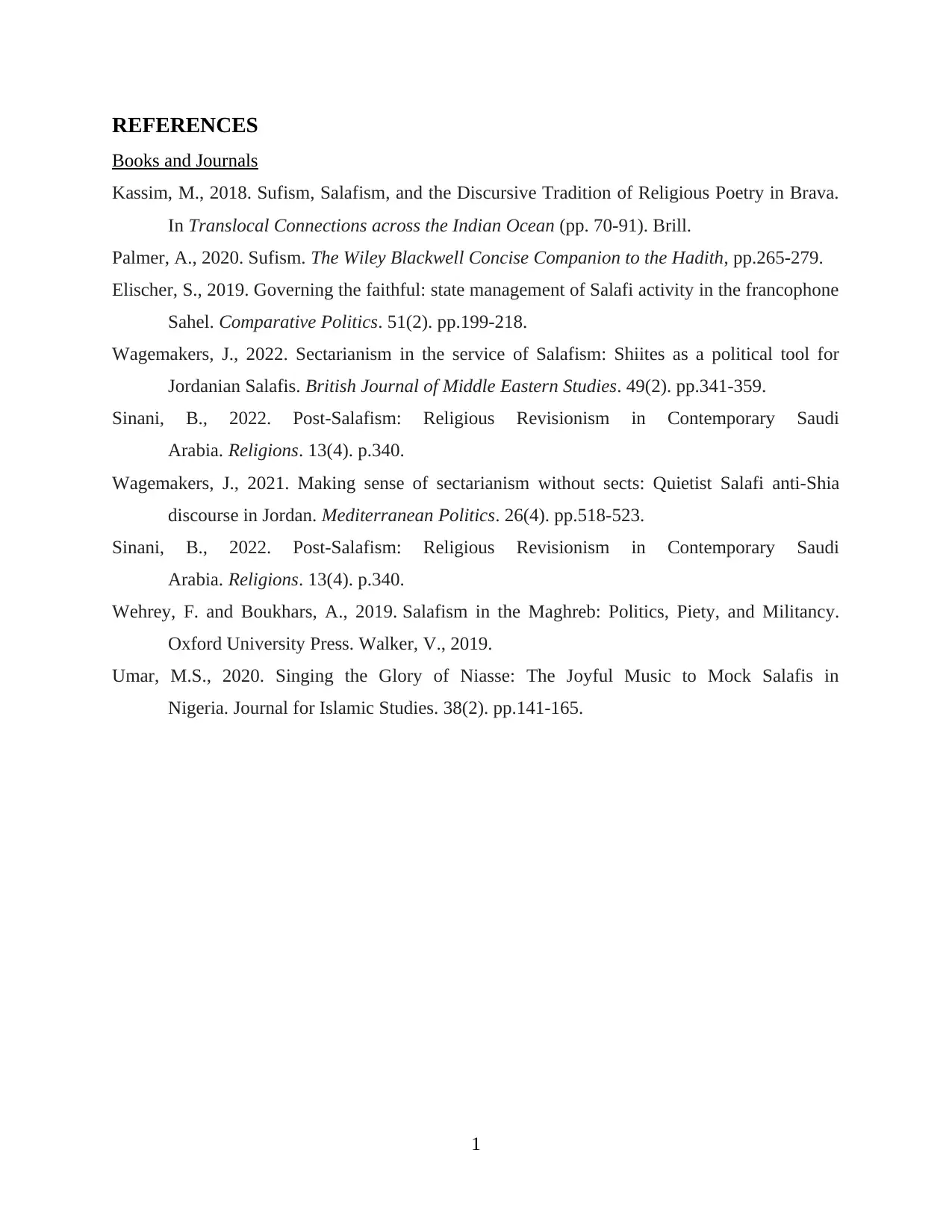
REFERENCES
Books and Journals
Kassim, M., 2018. Sufism, Salafism, and the Discursive Tradition of Religious Poetry in Brava.
In Translocal Connections across the Indian Ocean (pp. 70-91). Brill.
Palmer, A., 2020. Sufism. The Wiley Blackwell Concise Companion to the Hadith, pp.265-279.
Elischer, S., 2019. Governing the faithful: state management of Salafi activity in the francophone
Sahel. Comparative Politics. 51(2). pp.199-218.
Wagemakers, J., 2022. Sectarianism in the service of Salafism: Shiites as a political tool for
Jordanian Salafis. British Journal of Middle Eastern Studies. 49(2). pp.341-359.
Sinani, B., 2022. Post-Salafism: Religious Revisionism in Contemporary Saudi
Arabia. Religions. 13(4). p.340.
Wagemakers, J., 2021. Making sense of sectarianism without sects: Quietist Salafi anti-Shia
discourse in Jordan. Mediterranean Politics. 26(4). pp.518-523.
Sinani, B., 2022. Post-Salafism: Religious Revisionism in Contemporary Saudi
Arabia. Religions. 13(4). p.340.
Wehrey, F. and Boukhars, A., 2019. Salafism in the Maghreb: Politics, Piety, and Militancy.
Oxford University Press. Walker, V., 2019.
Umar, M.S., 2020. Singing the Glory of Niasse: The Joyful Music to Mock Salafis in
Nigeria. Journal for Islamic Studies. 38(2). pp.141-165.
1
Books and Journals
Kassim, M., 2018. Sufism, Salafism, and the Discursive Tradition of Religious Poetry in Brava.
In Translocal Connections across the Indian Ocean (pp. 70-91). Brill.
Palmer, A., 2020. Sufism. The Wiley Blackwell Concise Companion to the Hadith, pp.265-279.
Elischer, S., 2019. Governing the faithful: state management of Salafi activity in the francophone
Sahel. Comparative Politics. 51(2). pp.199-218.
Wagemakers, J., 2022. Sectarianism in the service of Salafism: Shiites as a political tool for
Jordanian Salafis. British Journal of Middle Eastern Studies. 49(2). pp.341-359.
Sinani, B., 2022. Post-Salafism: Religious Revisionism in Contemporary Saudi
Arabia. Religions. 13(4). p.340.
Wagemakers, J., 2021. Making sense of sectarianism without sects: Quietist Salafi anti-Shia
discourse in Jordan. Mediterranean Politics. 26(4). pp.518-523.
Sinani, B., 2022. Post-Salafism: Religious Revisionism in Contemporary Saudi
Arabia. Religions. 13(4). p.340.
Wehrey, F. and Boukhars, A., 2019. Salafism in the Maghreb: Politics, Piety, and Militancy.
Oxford University Press. Walker, V., 2019.
Umar, M.S., 2020. Singing the Glory of Niasse: The Joyful Music to Mock Salafis in
Nigeria. Journal for Islamic Studies. 38(2). pp.141-165.
1
1 out of 7
Your All-in-One AI-Powered Toolkit for Academic Success.
+13062052269
info@desklib.com
Available 24*7 on WhatsApp / Email
![[object Object]](/_next/static/media/star-bottom.7253800d.svg)
Unlock your academic potential
Copyright © 2020–2025 A2Z Services. All Rights Reserved. Developed and managed by ZUCOL.

